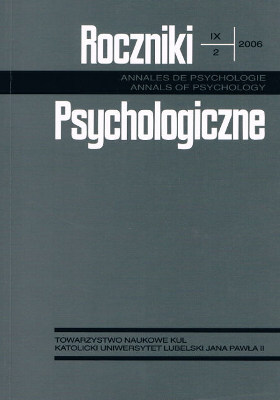Body self-perception in women with bulimia nervosa
Abstract
The aims of this article was to address the following questions: How do women with bulimia nervosa experience their own body? Which aspects of their bodily self are the basis of their identity and constitute essential elements of self structure? The study was conducted on 36 bulimic women, aged from 15 to 25, diagnosed according to DSM IV criteria for bulimia nervosa. The subjects were examined with the Body Self Questionnaire which consists of four scales (dimensions of the Body Self): acceptance of one’s body, disclosure of femininity, experience of intimate relations with persons of the opposite sex, and relationship towards eating and body weight. The conclusion from the study is: The body self of bulimic women is differentially disordered into three levels: profound, moderate and minimal.
References
American Psychiatric Association (1994). Diagnostic and statistical manual of mental Disorders (Fourth ed.). Washington, DC.
Beebe, D., Holmbeck, G. N., Grzeskiewicz, C. (1999). Normative and psychometric data on the body image assessment – revised. Journal of Personality Assessment, 3, 374-394.
Beumont, P. J. (1988). Bulimia: Symptoms, syndrome and predicament. W: K. Pirke, W. Vandereycken, D. Plogg (red.), The psychobiology of bulimia nervosa (s. 2-9). Berlin: Springer.
Braun-Gałkowska, M. (1985). Test Rysunku Rodziny. Lublin: KUL.
Braun-Gałkowska, M. (2002). Metody poznawania systemu rodzinnego. Lublin: Katedra Psychologii Wychowawczej i Rodziny KUL
Bruch, H. (1974). Eating disorders. Obesity, anorexia nervosa, and the person within. New York: Basic Books.
Cash, T. F., Deagle, E. A. (1997). The nature and extent of body-image disturbances in anorexia nervosa and bulimia nervosa: A meta-analysis. International Journal of Eating Disorders, 22, 107-125.
Chirpaz, F. (1998). Ciało. Warszawa: IFiS PAN.
Fernandez, F., Probst, M., Meermann, R., Vandereycken, W. (1994). Body size estimation and body dissatisfaction in eating disorder patients and normal controls. International Journal of Eating Disorders, 3, 307-310.
Franzen, U., Florin, I., Schneider, S. [i in.] (1988). Distorted body image in bulimic women. Journal of Psychosomatic Research, 4-5, 445-450.
Garner, D. M., Garfinkel, P. E. (1981-82). Body image in anorexia nervosa: Measurement, theory and clinical implications. International Journal of Psychiatric Medicine, 11, 263-284.
Gleaves, D. H., Williamson, D. A., Eberenz, K. P. [i in.] (1995). Clarifying body-image disturbance: Analysis of a multidimensional model using structural modeling. Journal of Personality Assessment, 3, 478-493.
Hsu, L. K., Sobkiewicz, T. A. (1991). Body image disturbance: Time to abandon the concept for eating disorders. International Journal of Eating Disorders, 10, 15-39.
Kent, A. (1991). Advances in bulimia nervosa. The Practitioner, 235, 396-399.
Krueger, D. W. (1989). Body self and psychological self. A developmental and clinical integration of disorders of the self. New York: Brunner/Mazel.
Kutlesic, V., Williamson, D., Gleaves, D. H., Barbin, J. M. (1998). The interview for the diagnosis of eating disorders – IV: Application to DSM-IV diagnostic criteria. Psychological Assessment, 1, 41-48.
Mirucka, B. (1996). Zdobywanie przestrzeni psychologicznej przez odrzucenie ciała. Psychosomatyczne aspekty zaburzeń odżywiania się. Test, 4, 93-102.
Mirucka, B. (2003). Poszukiwanie znaczenia cielesności i ja cielesnego. Przegląd Psychologiczny, 46, 2, 209-223.
Mirucka, B. (w druku). Kwestionariusz Ja Cielesnego. Przegląd Psychologiczny.
Ploog, D. (1988). Opening remarks. W: K. Pirke, W. Vandereycken, D. Plogg (red.), The psychobiology of bulimia nervosa (s. 1-15). Berlin: Springer.
Reich, G., Cierpka, M. (1998). Identity conflicts in bulimia nervosa: Psychodynamic patterns and psychoanalitic treatment. Psychoanalitic Inquiry, 3, 383-402.
Rosen, J. C. (1992). Body image disorder: Definition, development, and contribution to eating disorders. W: J. H. Crowther, D. L. Tennenbaum, S. E. Hobfoll, M. A. Stephens (red.), The etiology of bulimia nervosa: The individual and familial context (s. 157-177). Washington: Hemisphere Publishing Corporation.
Selvini Palazzoli, M. (1978). Self-starvation: From individual to family therapy in the treatment of anorexia nervosa. New York: Jasoa Aronson.
Slade, P. D., Brodie, D. (1994). Body-image distortion and eating disorders: A reconceptualization based on the recent literature. Eating Disorder Review, 2, 1, 32-46.
Sugarman, A. (1991). Bulimia: A displacement from psychological self to body self. W: C. L. Johnson (red.), Psychodynamic treatment of anorexia nervosa and bulimia (s. 3-33). New York: Guilford.
Touyz, S. W., Beumont, P. J. (1987). Body image and its disturbance. W: P. J. Beumont, R. Burrows, R. C. Casper (red.), Handbook of aeting disorders (cz. I, s. 171-187). Elsevier Science Publishers B. V.
Williamson, D., Davis, C. J., Bennett, S. M. [i in.] (1989). Development of a simple procedure for assessing body image disturbances. Behavioral Assessment, 11, 433-446.
Zerbe, K. (1993). Whose body is it anyway? Undertanding and treating psychosomatic aspects of eating disorders. Bulletin of Menninger Clinic, 2, 161-177.
Copyright (c) 2006 Roczniki Psychologiczne

This work is licensed under a Creative Commons Attribution-NonCommercial-NoDerivatives 4.0 International License.


